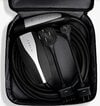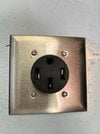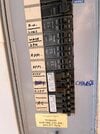Does the Tesla wall charger come with a 240V plug that can go into a normal wall outlet or do I have to buy an adapter? I have this plug in my garage already with the following circuit breaker. It says “charge” for the middle 50 amp breaker which I assume goes to this outlet in the garage?
Welcome to Tesla Motors Club
Discuss Tesla's Model S, Model 3, Model X, Model Y, Cybertruck, Roadster and More.
Register
Install the app
How to install the app on iOS
You can install our site as a web app on your iOS device by utilizing the Add to Home Screen feature in Safari. Please see this thread for more details on this.
Note: This feature may not be available in some browsers.
-
Want to remove ads? Register an account and login to see fewer ads, and become a Supporting Member to remove almost all ads.
You are using an out of date browser. It may not display this or other websites correctly.
You should upgrade or use an alternative browser.
You should upgrade or use an alternative browser.
How to set up Tesla Wall charger
- Thread starter gdgraph
- Start date
Does the Tesla wall charger come with a 240V plug that can go into a normal wall outlet or do I have to buy an adapter? I have this plug in my garage already with the following circuit breaker. It says “charge” for the middle 50 amp breaker which I assume goes to this outlet in the garage?
If you have purchased the Tesla Mobile connector (it comes with NEMA 14-50 that plugs into the Mobile Connector, and the other end plugs into your electrical outlet).
Tesla wall connector is for hardwire installation. You can learn about the difference between the mobile and wall connector here.

Upvote
0
No, the wall connector wont plug into that. You want a mobile connector if you want to plug into that. If you want a wall connector, you would remove the outlet and mount the wall connector in its place.
You may also read people say "but I put a cord on my wall connector". Thats possible, but its not "to code" so anyone who has to ask about converting a wall connector to a plug, probably shouldnt do it.
You may also read people say "but I put a cord on my wall connector". Thats possible, but its not "to code" so anyone who has to ask about converting a wall connector to a plug, probably shouldnt do it.
Upvote
0
3sr+buyer
Active Member
The receptacle in the photo looks like a Leviton 279-S00, with half size steel contacts to the plug blades. If you plug in a Tesla Mobile Connector, it may result in complaints about overheating at currents over ~26A or so during warm weather and cause the charging current to be reduced.
If you want to use a Tesla Mobile Connector or other plug-in EVSE, it is best to use a receptacle with full size brass contacts to the plug blades. However, this may require a box extension, since the Leviton 279-S00 is of a compact design that fits in smaller boxes than most other 14-50 receptacles.
A Tesla Wall Connector is meant for hardwire installation, so you would remove the receptacle and connect it directly to the wires in the box (capping off the unused wire).

If you want to use a Tesla Mobile Connector or other plug-in EVSE, it is best to use a receptacle with full size brass contacts to the plug blades. However, this may require a box extension, since the Leviton 279-S00 is of a compact design that fits in smaller boxes than most other 14-50 receptacles.
A Tesla Wall Connector is meant for hardwire installation, so you would remove the receptacle and connect it directly to the wires in the box (capping off the unused wire).
Upvote
0
The label on the outlet says NEMA 14-50R on one side and 50A-125/250V on the other. Is this definitely going to have overheating/reduced charging?The receptacle in the photo looks like a Leviton 279-S00, with half size steel contacts to the plug blades. If you plug in a Tesla Mobile Connector, it may result in complaints about overheating at currents over ~26A or so during warm weather and cause the charging current to be reduced.
If you want to use a Tesla Mobile Connector or other plug-in EVSE, it is best to use a receptacle with full size brass contacts to the plug blades. However, this may require a box extension, since the Leviton 279-S00 is of a compact design that fits in smaller boxes than most other 14-50 receptacles.
A Tesla Wall Connector is meant for hardwire installation, so you would remove the receptacle and connect it directly to the wires in the box (capping off the unused wire).

Upvote
0
No it isn’t definitely going to have issues. The Tesla Mobile Connector will charge at 32A on such a receptacle and chances are very good that it’ll work just fine. There are a lot of people here that are a bit over the top with their recommendations.The label on the outlet says NEMA 14-50R on one side and 50A-125/250V on the other. Is this definitely going to have overheating/reduced charging?
Do you have a Tesla Wall Connector? Or a Mobile Connector? Or neither and you’re wondering what to buy? What kind of car do you have and how much driving do you do?
Upvote
0
3sr+buyer
Active Member
I had a similar Leviton NEMA 6-50 receptacle with half size steel contacts to the plug blades and had overheating issues during warm weather when charging at greater than about 26A (in cooler weather, there were no overheating issues). After replacing it with a different NEMA 6-50 receptacle that had full size brass contacts to the plug blades, the overheating issues went away.The label on the outlet says NEMA 14-50R on one side and 50A-125/250V on the other. Is this definitely going to have overheating/reduced charging?
Upvote
0
Neither, I’m considering an EV and just wanted to understand if charging at home would work with that outlet and what I’d need to buy/install. I’m also renting so I don’t want to invest a bunch on an install.No it isn’t definitely going to have issues. The Tesla Mobile Connector will charge at 32A on such a receptacle and chances are very good that it’ll work just fine. There are a lot of people here that are a bit over the top with their recommendations.
Do you have a Tesla Wall Connector? Or a Mobile Connector? Or neither and you’re wondering what to buy? What kind of car do you have and how much driving do you do?
I commute about 22 miles each way to work, primarily highway driving at around 75-80mph
Upvote
0
Neither, I’m considering an EV and just wanted to understand if charging at home would work with that outlet and what I’d need to buy/install. I’m also renting so I don’t want to invest a bunch on an install.
I commute about 22 miles each way to work, primarily highway driving at around 75-80mph
In the above circumstance, you should just buy a tesla mobile connector (not wall connector).
Upvote
0
So, let's take this from the top so it all makes a bit more sense. I'm going to hit you with some concepts, then some math.Neither, I’m considering an EV and just wanted to understand if charging at home would work with that outlet and what I’d need to buy/install. I’m also renting so I don’t want to invest a bunch on an install.
I commute about 22 miles each way to work, primarily highway driving at around 75-80mph
First: Energy is (usually) measured in Joules and is a quantity, like a bucket with a gallon of water.
Second: Power is the rate of usage of energy. A Watt (another one of those white-haired gentlemen from long ago) is the unit of power; and, at a steady rate of usage, 1 W = 1 Joule/second. That 100 W lightbulb in your overhead? Yep, it's using 100 J/second.
For various historical reasons, the power companies of the world decided to express energy in terms of Watt-Hours. 1 KW-hr (1000 Watt-hours) is 3.6 MJ, exactly. When you get your electric bill, they charge your for how much energy your houses has used, and they charge you so-many-cents per kW-hr. The electric car guys follow suit, so battery capacity (i.e., how much energy a battery can store) is measured in kW-hrs. For example, my Model 3 has an 85 kW-hr battery in it, or at least it held 85 kW-hr when it was new.
Going along these lines, then, electric cars' efficiencies are measured in W-hr/mile. (That is, how much energy it takes to move the car a mile down the road.) That rating is pretty much exactly the same as (you're going to love this) Gallons/mile. Which is upside down to how the EPA usually measures things, but go figure.
So, let's take a couple of typical Teslas: A Model 3 and a Model Y. The Model 3 uses 250 W-hr/mile; the Model Y uses 280 W-hr/mile. Let's stick with the Model 3, you can substitute in the EPA efficiency by looking at the car you're planning to buy at epa.gov, looking it up, and getting the efficiency from there.
So: How fast will a Model 3 charge when hooked up to a source of 240 V? Back to Power.
Let's say you've got a NEMA14-50 and a Tesla Mobile Connector. The latter comes in a cloth bag. One end of the TMC plugs into the car; the other end takes a number of adapters and lets say you get the NEMA14-50 adapter. Plug the adapter end into that NEMA14-50; the TMC has a limit of 32A, and the Power from that is
P = 240 * 32 = 7.68 kW.
What you want to know is how fast the car will charge, in miles of charge per hour. Watch this:
Time = 7.68 kW/(0.25 kW-hr/mile) = 30.7 miles/hour. Note how the "kw's" cancel, and you end up with miles per hour in the units.
So: a Model 3 LR has about 320 miles of range or so. How long would it take to charge a completely empty one?d
320 miles/(30.7 miles/hour) = 10.4 hours. That is: Overnight.
Nobody sane runs around with a completely empty car; it's typical to wait for the car to get down to 20% charge or so, but, it being a Tesla, one typically charges it up to 80% for typical running-around-the-landscape tasks. The difference is 60% of 320 miles, or 192 miles; let's call it 200 miles. That would take
200/30.7 = 6.5 hours. Which also qualifies as "overnight".
If you're commuting 44 miles a day, you'll probably charge once or twice a week, although there are various reasons in the winter when you might like to pre-heat the car before driving out the garage door, in which case you might leave it plugged in.
Now, the other choice you could do is get a Tesla Wall Connector. (Or, if you're getting some other kind of BEV, something like a Juicebox or what-all; there's lots of different brands.) Nearly all of these are designed to be directly wired to the breakers in a breaker panel. The advantages these things have over the Tesla Mobile Connector (or the equivalent from other car manufacturers) are two fold:
- They can do more current. With the right car a TWC can do 48A at 240V.
- Convenient. The cable coils around the box on the wall. And if you have a TMC, you leave it in the trunk, where $DIETY intended
 .
.
Now for a couple of snivveys. If one is putting in a NEMA14-50 into a garage, new (which you're not doing), current NEC code says you have to have a GFCI breaker in the breaker panel. If one adds up the costs of a good NEMA14-50 and a GFCI, turns out it's about the same as a TWC, which doesn't need the GFCI. So, a lot of people around here have the advice, when asked about NEMA vs. Wall Connector, to state, "Wall Connector, of course!". But you have a pre-existing NEMA14-50 there; the one you've got can handle the 32A from the TMC; so, well, you're done, stick a fork in it.
Second snivvy is kind of weird, but true. Turns out that if one looks at the possible NEMA connectors out there, there are 15A connectors, 20A connectors, 30A connectors, and 50A connectors. And no 40A connectors.
However, there are 40A loads - like clothes driers and electric ovens. Next bit: Copper is EXPENSIVE. So, the general rule is that the breaker, the wire, and the connector all have to have the same rating: If you've got a 120 VAC 15A circuit, then the breaker is 15A, the wire can handle 15A, and the wall sockets in your house handle 15A. So, what to do about that blame clothes drier? Electricians don't want to put that 50A wire in, it's $$. So, the NEC gave them an out: With a 40A load, it's code to put in a 40A breaker, 40A wire... and a NEMA14-50 socket, that one is supposed to label as only being good for 40A.
Ha. As if (a) that label is going to be there after 20 years and (b) $RANDOM user isn't going to plug a 50A load into it anyway. And if one actually runs a 50A circuit with 40A wire, there is the Real Possibility Of Setting The House On Fire. Which is not a good thing.
So, back to Tesla. They have a NEMA14-50 adapter for their TMC. But they people at Tesla have no clue whether that's being plugged into a true, 50A socket, wire, breaker collection (in which case, it's allowable to draw 40A continuous) or if it's plugged into a 40A breaker, 40A wire, but 50A socket. In which case the maximum allowable current is 80% of the 40A, or 32A.
So they play it safe. Max current on a TMC is 32A. Safety first!
Hope this helps.
Upvote
0
Yeah, I’d just buy the Tesla Mobile Connector and use the outlet. It’ll work fine for you.Neither, I’m considering an EV and just wanted to understand if charging at home would work with that outlet and what I’d need to buy/install. I’m also renting so I don’t want to invest a bunch on an install.
I commute about 22 miles each way to work, primarily highway driving at around 75-80mph
Upvote
0
3sr+buyer
Active Member
In this case (assuming the EV is a Tesla), just get a Mobile Connector with 14-50 plug adapter and plug it in. If you get overheating warnings (with resulting reduction of amperage to 16A), try setting the car to charge at a slightly lower amperage than 32A (the Mobile Connector's maximum).Neither, I’m considering an EV and just wanted to understand if charging at home would work with that outlet and what I’d need to buy/install. I’m also renting so I don’t want to invest a bunch on an install.
Upvote
0
davewill
Active Member
With all due respect to @Cosmacelf, I personally, would not use that Leviton outlet for daily charging. Is it likely to melt the first time you use it? No, probably not, but we've seen enough of them do so, that it is prudent to spend the money to upgrade it.The label on the outlet says NEMA 14-50R on one side and 50A-125/250V on the other. Is this definitely going to have overheating/reduced charging?
Upvote
0
If you’re really worried about it, with the OP’s driving habits, set the car the charge at 24A and you’re good to go.With all due respect to @Cosmacelf, I personally, would not use that Leviton outlet for daily charging. Is it likely to melt the first time you use it? No, probably not, but we've seen enough of them do so, that it is prudent to spend the money to upgrade it.
Btw, you’ve now probably scared away another potential EV buyer.
Upvote
0
davewill
Active Member
Really? Just because I think he should change out an outlet? If the dude is THAT skittish, maybe he SHOULDN'T own one...but I rather doubt he is.If you’re really worried about it, with the OP’s driving habits, set the car the charge at 24A and you’re good to go.
Btw, you’ve now probably scared away another potential EV buyer.
Upvote
0
Similar threads
- Replies
- 19
- Views
- 589
- Question
- Replies
- 16
- Views
- 2K
- Replies
- 82
- Views
- 3K
- Replies
- 12
- Views
- 417
- Replies
- 7
- Views
- 837




